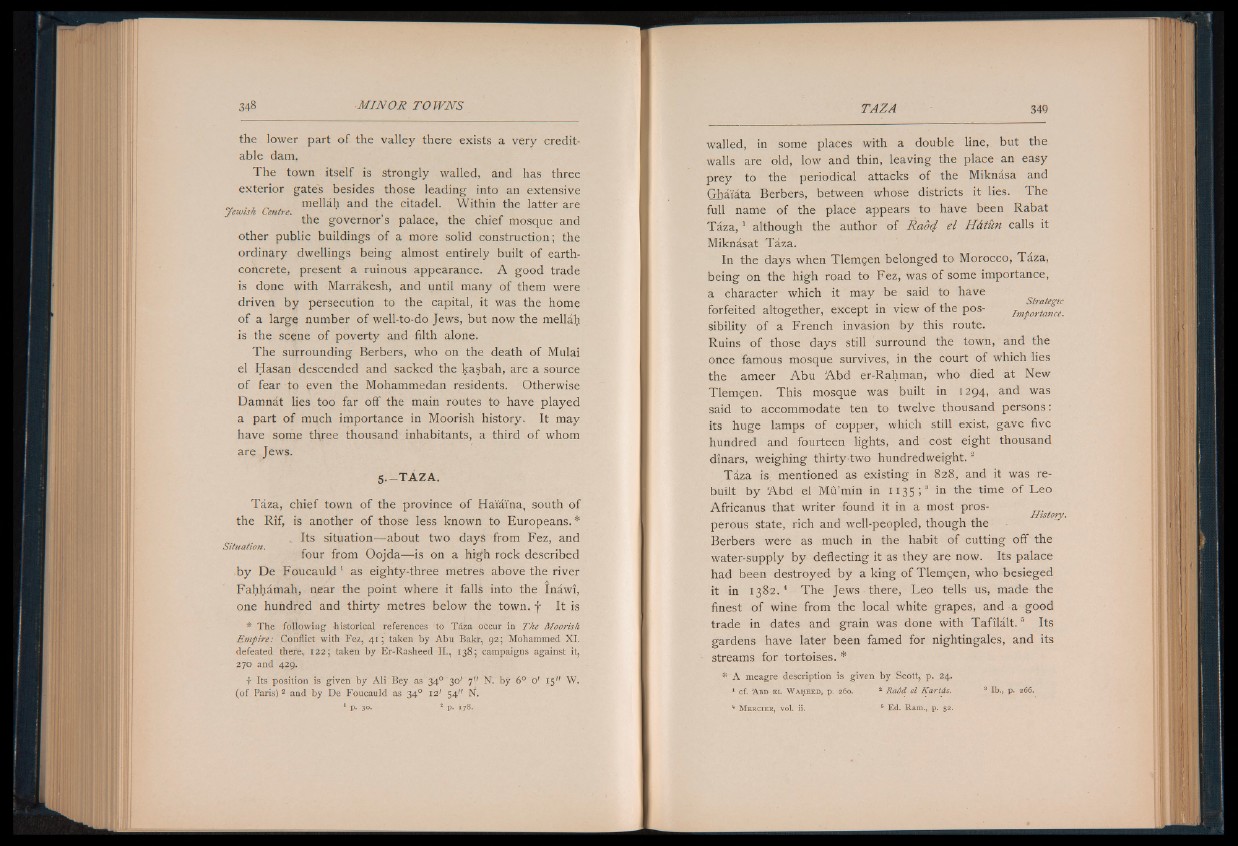
the lower part o f the valley there exists a very creditable
dam.
The town itself is strongly walled, and has three
exterior gate's besides those leading into an extensive
„ mellah and the citadel. Within the latter are
Jewish Centre. . ,
the governor s palace, the chief mosque and
other public buildings of a more solid construction; the
ordinary dwellings being almost entirely built of earthconcrete,
present a ruinous appearance. A good trade
is done with Marrakesh, and until many of them were
driven by persecution to the capital, it was the home
of a large number of well-to-do Jews, but now the mellah
is the scene of poverty and filth alone.
The surrounding Berbers, who on the death of Mulai
el Hasan descended and sacked the kasbah, are a source
of fear to even the Mohammedan residents. Otherwise
Damnat lies too far off the main routes to have played
a part of much importance in Moorish history. It may
have some three thousand inhabitants, a third of whom
are Jews.
5.-T A Z A .
Taza, chief town of the province of Haiaina, south of
the Rif, is another of those less known to Europeans. *
. Its situation— about two days from Fez, and
four from Oojda— is on a high rock described
by De Foucauld 1 as eighty-three metres above the river
Fahhamah, near the point where it falls into the Inawi,
one hundred and thirty metres below the town, f It is
* The following historical references to Taka occur in The Moorish
Empire: Conflict with Fez, 41; taken by Abu Bakr, 92; Mohammed XI.
defeated there, 122; taken by Er-Rasheed II., 138; campaigns against it,
270 and 429.
f Its position is given by Ali Bey as 340 30' 7" N. by 6° o' 15” W.
(of Paris) 3 and by De Foucauld as 340 121 54" N.
1 p. 30. I p. 178.
walled, in some places with a double line, but the
walls are old, low and thin, leaving the place an easy
prey to the periodical attacks of the Miknasa and
Ghaiata Berbers, between whose districts it lies. The
full name of the place appears to have been Rabat
T a z a ,1 although the author of Radd e l Hdtiin calls it
Miknasat Taza.
In the days when Tlemgen belonged to Morocco, Taza,
being on the high road to Fez, was of some importance,
a character which it may be said to have
r ., Strategic
forfeited altogether, except in view 01 the pos- importance.
sibility of a French invasion by this route.
Ruins of those days still surround the town, and the
once famous mosque survives, in the court of which lies
the ameer Abu Abd er-Rahman, who died at New
Tlemgen. This mosque was built in 1294, and was
said to accommodate ten to twelve thousand persons:
its huge lamps of copper, which still exist, gave five
hundred and fourteen lights, and cost eight thousand
dinars, weighing thirty-two hundredweight.2
Taza is; mentioned as existing in 828, and it was rebuilt
by Abd el Mu’min in 113 5 ; 3 in the time of Leo
Africanus that writer found it in a most pros- History,
perous state, rich and well-peopled, though the
Berbers were as much in the habit of cutting off the
water-supply by deflecting it as they are now. Its palace
had been destroyed by a king of Tlemgen, who besieged
it in 1382.4 The Jews there, Leo tells us, made the
finest of wine from the local white grapes, and a good
trade in dates and grain was done with Ta fila lt.5 Its
gardens have later been famed for nightingales, and its
streams for tortoises. *
* A meagre description is given by Scott, p. 24.
1 cf. A b d e l W a h e e d , p. 260. 2 Radd el Kart&s. 3 lb., p. 266.